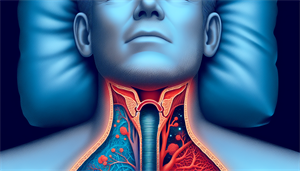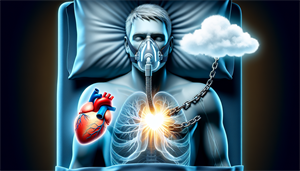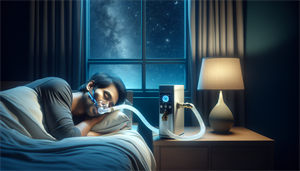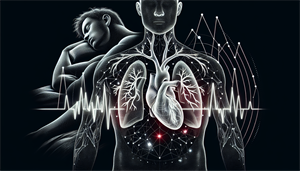Imagine a health condition so insidious that it could potentially steal years off your life, and yet, it occurs when you’re in the most peaceful state - sleep. This is the reality for those living with sleep apnea, a sleep disorder that not only robs you of restful nights but may also dramatically increase your risk of mortality. Many people wonder, “What are the chances of dying from sleep apnea?” as they seek to understand the severity of this disorder.
Key Takeaways
-
Sleep apnea is a serious sleep disorder with different types, primarily obstructive sleep apnea (OSA), central sleep apnea (CSA), and complex sleep apnea, each presenting unique challenges and risks, including elevated mortality if left untreated.
-
The condition poses immediate dangers like sudden cardiac death due to arrhythmias, as well as long-term health risks such as stroke, heart failure, diabetes, and cognitive impairments, all potentially leading to premature death.
-
Treatments, especially the use of Continuous Positive Airway Pressure (CPAP) therapy and lifestyle changes like weight loss and exercise, can effectively manage sleep apnea and significantly reduce associated health risks and mortality rates.
Understanding Sleep Apnea and Its Types

Sleep apnea is a sleep disorder characterized by decreased or interrupted breathing patterns during sleep. It manifests in three types: obstructive sleep apnea (OSA), central sleep apnea (CSA), and complex sleep apnea. Each type has its unique characteristics and challenges, contributing to the increased risk of mortality.
Obstructive Sleep Apnea Explained

Obstructive sleep apnea syndrome (OSAS) is defined by the following characteristics:
-
Repetitive closure of the upper airway during sleep
-
Repeated reversible decreases in blood oxygen levels
-
Fragmented sleep
-
Relaxation and narrowing of throat muscles
-
Interruptions in breathing during sleep
These factors contribute to the symptoms and effects of OSA.
The typical symptoms associated with untreated obstructive sleep apnea can be managed with sleep apnea treatment, which may include continuous positive airway pressure (CPAP) therapy, lifestyle changes, or surgery. Prompt treatment of this condition is necessary to prevent complications.
In severe cases, OSA events can occur with a frequency of more than 30 times per hour, increasing the risk of complications and the chances of death if left untreated.
Central Sleep Apnea: The Less Common Variant
Unlike OSA, central sleep apnea (CSA) is characterized by the brain and respiratory muscles’ inability to properly regulate breathing. This means that the issue is not a physical blockage, but rather a miscommunication between the brain and the muscles that control breathing.
The signs and symptoms of central sleep apnea closely resemble those of obstructive sleep apnea. However, individuals with central sleep apnea may not frequently report daytime sleepiness compared to those with obstructive sleep apnea, which is often linked to cardiovascular disease.
Addressing the underlying cause of central sleep apnea may assist in improving sleep quality and mitigating other symptoms and complications associated with CSA. This highlights the need to comprehend one’s type of sleep apnea and secure an accurate diagnosis and treatment.
Complex Sleep Apnea: A Combination of Challenges
Complex sleep apnea is a condition characterized by the combination of obstructive sleep apnea (OSA) and central sleep apnea (CSA). It may develop in certain individuals who are undergoing continuous positive airway pressure (CPAP) sleep apnea treatment for OSA.
The estimated prevalence of complex sleep apnea is 5 to 15% of patients with sleep-disordered breathing. Indications of complex sleep apnea encompass:
-
Severe fatigue
-
Daytime drowsiness
-
Irritability
-
Profound daytime tiredness
-
Excessive daytime sleepiness
-
Depression
-
Anxiety
-
Disruptions in brain function
-
Memory loss
-
Difficulty concentrating
The Mortality Risk Associated with Sleep Apnea

Sleep apnea is not just about disturbed sleep; it’s a potential life-threatening condition. In fact, sleep apnea dangerous consequences carry a substantial mortality risk, including the immediate peril of sudden cardiac death and the long-term repercussions of premature death due to chronic illness.
Immediate Dangers: Sudden Cardiac Death and Sleep Apnea
Sudden cardiac death is the predominant form of rapid fatality associated with sleep apnea, and scholars have established a connection to common risk factors such as heart disease and high blood pressure. These unforeseen fatalities serve as a harsh reminder of sleep apnea’s gravity and the necessity of prompt intervention.
The mechanisms thought to result in sudden cardiac death in patients with sleep apnea involve the impact of obstructive sleep apnea on the variability of heart rate and the electrical stability of the heart muscle or myocardium. In other words, sleep apnea can cause irregular heart rhythms that can lead to sudden cardiac death.
The severity of sleep apnea and the level of oxygen in the blood can also influence the risk of sudden cardiac death. As such, managing sleep apnea is not just about improving sleep quality, but it could be a matter of life and death. A sleep heart health study can provide valuable insights into this connection.
Long-Term Consequences: Chronic Illness and Premature Death
Untreated sleep apnea can lead to a variety of health problems, including:
-
diabetes
-
insulin resistance
-
vascular changes
-
stroke
-
heart failure
-
abnormal heart rhythms
-
cognitive impairments
All of these can potentially increase the risk of premature death. These long-term effects highlight the necessity of effective sleep apnea management.
Obstructive sleep apnea is considered an independent risk factor for stroke and may potentially act as a direct trigger. Untreated sleep apnea has been linked to unfavorable outcomes following a stroke, further emphasizing the need for prompt diagnosis and treatment.
Moreover, sleep apnea has the potential to be life-threatening as a result of the ensuing oxygen deprivation. It is crucial to seek appropriate treatment as it can significantly reduce the likelihood of complications, including:
-
sudden death
-
heart disease
-
high blood pressure
-
stroke
-
diabetes
-
depression
-
memory problems
There are several health risks that are linked to sleep apnea, and in some severe cases, individuals may even die from sleep apnea.
Evaluating the Severity: How Sleep Apnea Impacts Mortality Rates

Sleep apnea severity significantly impacts mortality rates. Although all types of sleep apnea are hazardous, severe instances are especially perilous, emphasizing the need for precise diagnosis and severity classification of the condition.
Mild Sleep Apnea: A Look at the Numbers
If left untreated, even mild sleep apnea can lead to significant health consequences. Approximately 19 percent of individuals with severe sleep apnea experienced mortality, in contrast to around four percent of individuals with no sleep apnea.
Untreated mild sleep apnea can have a significant impact on an individual’s life expectancy, potentially reducing it by around 12-15 years. Therefore, effective management of even mild sleep apnea is crucial to prevent these severe consequences.
Mild sleep apnea is diagnosed by evaluating symptoms and specific comorbidities associated with five or more breathing apneic events in one hour. This highlights the importance of recognizing and diagnosing even mild symptoms of sleep apnea.
Severe Sleep Apnea: Understanding the Higher Mortality Risk
Severe sleep apnea presents a markedly elevated risk of mortality in comparison to mild cases of sleep apnea. Severe sleep apnea can have precise effects on cardiovascular health, such as:
-
an elevated risk of hypertension
-
stroke
-
heart failure
-
coronary artery disease
-
coronary events
Severe sleep apnea can also impact respiratory function by causing the airways to narrow or close during sleep, resulting in periods of interrupted breathing known as apneas. These disruptions in breathing can lead to oxygen deprivation, which can have serious health consequences.
Males with moderate/severe sleep apnea exhibit a moderately heightened susceptibility to all-cause mortality in contrast to the general population, especially among those aged 50 years. This highlights the need to acknowledge sleep apnea’s severity and apply suitable management strategies.
Can Treatment Reduce Your Risk?

Although sleep apnea can be intimidating, it’s encouraging to know that treatments can significantly lessen the associated risks. From Continuous Positive Airway Pressure (CPAP) therapy to lifestyle modifications, various management strategies can improve the condition and, in turn, reduce the risk of mortality.
Continuous Positive Airway Pressure (CPAP): A Lifesaver?
Continuous Positive Airway Pressure (CPAP) therapy is a widely utilized approach for addressing obstructive sleep apnea. This treatment involves:
-
A machine that delivers a continuous flow of air
-
A mask worn during sleep
-
Effectively maintaining open airways
-
Preventing respiratory disruptions
The utilization of a CPAP machine has the potential to:
-
Substantially reduce the risk of all-cause mortality for individuals suffering from obstructive sleep apnea
-
Enhance sleep quality
-
Lower the mortality risk linked to sleep apnea
This demonstrates the effectiveness of CPAP therapy in improving sleep quality and reducing the risk of mortality associated with sleep apnea.
While CPAP therapy can be incredibly effective, it requires consistency and adherence to the treatment plan. Therefore, patient education and follow-up are critical to ensure the effectiveness of the treatment.
Lifestyle Modifications and Their Impact on Sleep Apnea
In addition to CPAP therapy, severe sleep apnea can also be managed through lifestyle modifications and sleep medicine, which can help treat sleep apnea. These may encompass weight control, exercise, and the avoidance of alcohol and sedatives.
For individuals who are overweight, the initial and most efficacious step in addressing sleep apnea often involves weight loss, as it can alleviate pressure on the respiratory passages. Weight loss has been shown to have a significant impact on reducing obstructive sleep apnea related symptoms, and in some cases, it can even lead to a complete cure of the condition.
Exercise has the potential to enhance sleep quality, alleviate symptoms, and reduce the severity of obstructive sleep apnea. Thus, lifestyle modifications, while beneficial for general health, can also play a key role in managing sleep apnea and decreasing its associated risks.
When to Seek Help: Recognizing Symptoms and Getting Diagnosed
Recognizing the symptoms of sleep apnea and seeking a diagnosis is the first step towards managing the condition. Key symptoms of sleep apnea encompass snoring, restless sleep, and experiencing gasping during sleep, often identifiable by others rather than the patient.
Undergoing a sleep apnea test is crucial because:
-
A significant number of individuals with the condition are not cognizant of their nocturnal breathing interruptions
-
Timely testing plays a pivotal role in early detection of sleep apnea
-
Initiating prompt treatment can reduce associated health hazards
If an individual suspects they have sleep apnea, they should communicate their symptoms to their primary care physician. The physician may suggest a sleep study known as polysomnography, which can be performed at a sleep laboratory or at home. This test records brain waves, heart rate, and breathing patterns to accurately diagnose sleep apnea.
Advanced Options: Exploring Surgical Interventions for Sleep Apnea
While lifestyle changes and CPAP therapy are often the first line of treatment, in some cases, surgical interventions can be considered for treating sleep apnea. These are typically recommended for individuals who do not respond to other treatments or have specific anatomical issues contributing to their sleep apnea.
Uvulopalatopharyngoplasty (UPPP) is a surgical procedure designed to address obstructive sleep apnea by enlarging the airway through the removal of excess throat tissue. However, its effectiveness is contingent upon individual factors, and success rates have been documented to range from 25% to 80%.
Weight loss surgeries can indirectly aid in the management of sleep apnea by reducing excess tissue that may be causing airway obstruction. It is technically classified as a form of tissue removal surgery for sleep apnea. However, surgical interventions should be considered only after thorough consultation with healthcare professionals.
Untreated Sleep Apnea: A Silent Killer
Untreated sleep apnea may result in significant health complications and an elevated risk of mortality. Without treatment, individuals with sleep apnea are potentially at risk of several health issues that could drastically reduce their life expectancy.
Failure to address sleep apnea may lead to its exacerbation and the development of other health complications that may rapidly advance and deteriorate. Therefore, it’s vital to handle sleep apnea with seriousness and seek immediate treatment.
Remember, sleep apnea isn’t just about disruptive snoring or daytime fatigue; it’s a silent killer that can quietly erode your health and life expectancy.
Summary
Sleep apnea is a serious condition that can significantly increase mortality rates if left untreated. The condition manifests in three types: obstructive sleep apnea, central sleep apnea, and complex sleep apnea, each carrying unique challenges and risks. With symptoms ranging from loud snoring to daytime sleepiness, timely recognition and diagnosis are crucial in managing the condition and reducing associated risks.
Treatment options for sleep apnea range from lifestyle modifications to CPAP therapy and even surgical interventions. Regardless of the treatment path, the goal remains the same: to manage the condition effectively, improve sleep quality, and ultimately reduce the risk of mortality associated with sleep apnea. Remember, sleep apnea is not merely a sleep disorder; it’s a potential life-thief that can be tamed with awareness, timely intervention, and effective management.
Frequently Asked Questions
Is death from sleep apnea common?
While death from sleep apnea is rare, research indicates that it is more common in older individuals with severe apnea or very low oxygen levels. It is important to seek treatment for sleep apnea to reduce the risk of such complications.
How many years can you live with sleep apnea?
With proper treatment such as oral appliance therapy or a CPAP machine, individuals under 50 with severe sleep apnea can expect to live between eight to 18 years. Regular diagnosis and treatment are essential for managing sleep apnea and improving longevity.
What happens if I don't use my CPAP for a week?
If you don't use your CPAP for a week, your airway may collapse during sleep, leading to decreased oxygen levels, extreme fatigue, fogginess, and irritability. This could result in serious health consequences.
What is the mortality rate for sleep apnea by age?
The mortality rate for sleep apnea varies by age, with males aged 20-29 having a relative mortality rate of 9.8, which decreases with age. This suggests that younger males may face a higher mortality risk from sleep apnea.
Related health topics?
To learn more about related health topics, you can explore information on coronavirus disease (COVID-19), reproductive health, air pollution, obesity, mental health, and vaccines. Stay informed to make healthy choices.


